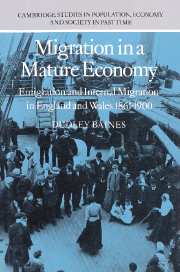Book contents
- Frontmatter
- Contents
- List of tables
- List of figures
- Acknowledgements
- 1 Introduction: the scope of the study
- 2 Issues in the history of European emigration, 1840–1914
- 3 The characteristics of British emigrants before 1914
- 4 The estimation of migration by county of birth
- 5 Return migration to Britain, 1860–1914
- 6 The birthplace of English and Welsh emigrants, 1861–1900
- 7 English and Welsh emigrants in the 1880s and 1890s
- 8 Emigration and urban growth
- 9 Rural-urban stage emigration, 1861–1900
- 10 Wales and the Atlantic economy, 1861–1914
- A summary of conclusions
- Appendices
- Bibliography
- Index
10 - Wales and the Atlantic economy, 1861–1914
Published online by Cambridge University Press: 24 November 2009
- Frontmatter
- Contents
- List of tables
- List of figures
- Acknowledgements
- 1 Introduction: the scope of the study
- 2 Issues in the history of European emigration, 1840–1914
- 3 The characteristics of British emigrants before 1914
- 4 The estimation of migration by county of birth
- 5 Return migration to Britain, 1860–1914
- 6 The birthplace of English and Welsh emigrants, 1861–1900
- 7 English and Welsh emigrants in the 1880s and 1890s
- 8 Emigration and urban growth
- 9 Rural-urban stage emigration, 1861–1900
- 10 Wales and the Atlantic economy, 1861–1914
- A summary of conclusions
- Appendices
- Bibliography
- Index
Summary
A common view in recent years is that Welsh migration in the late nineteenth and early twentieth century was qualitatively different from English. The main contributions have been made by Professor Brinley Thomas in 1959 and 1961 and (in an important restatement of his view) in 1972. They have been taken up by several Welsh historians.
The hypothesis of a distinctive Welsh migration pattern rests on the existence of a distinct Welsh economy and on the position of South Wales within it. Brinley Thomas argued that Welsh industry was geared almost entirely to the export trade in coal and that the ‘rate or growth of output of coal in Wales synchronised with fluctuations in the British export sector’. According to Brinley Thomas this had two consequences. In the first place, Wales had an inverse migration cycle and second the rate of emigration from Wales was low. Expansion in the South Wales coalfield was fastest in the decades 1881–90 and 1901–10, that is, in the decades when the long swing in English domestic investment turned down, and the North American long swing turned up. Hence, emigration from Wales was low when emigration from England was high. Similarly, rural-urban migration was relatively low in England in the 1880s and 1900s but relatively high in Wales. The main evidence used by Professor Thomas is thenet gains and losses by migration in English and Welsh urban and rural areas. These are the familiar Welton/Cairncross estimates, slightly amended.
- Type
- Chapter
- Information
- Migration in a Mature EconomyEmigration and Internal Migration in England and Wales 1861–1900, pp. 266 - 278Publisher: Cambridge University PressPrint publication year: 1986

